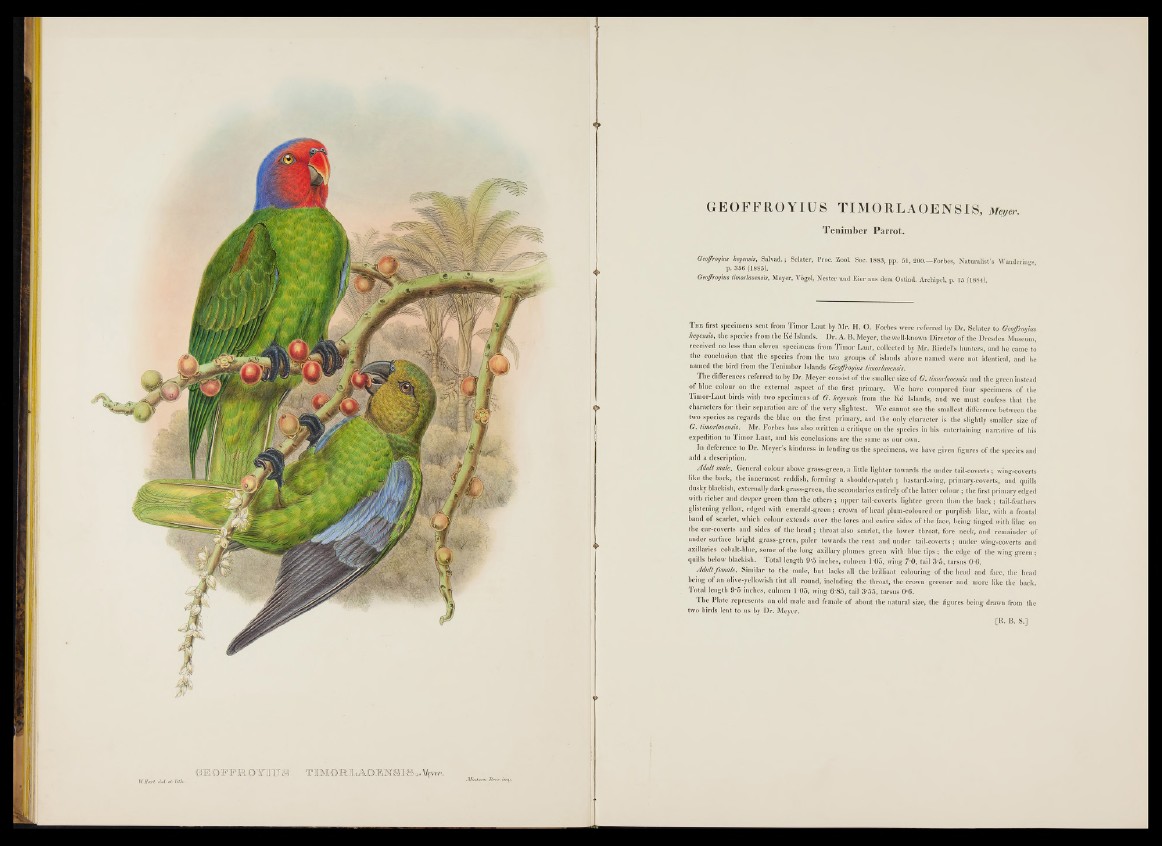
KE ©FFROYJLUS T IM O R I lA O M S IS „Meyer.
GEOFFROYIUS TIMORLAOENSIS, Meyer.
Tenimber Parrot.
Geoffroyius keyensis, Salvad.; Sclater, Proc. Zool. Soc. 1883, pp. 51, 200.—Forbes, Naturalist’s Wanderings
p. 356 (1885).
Geoffroyius timorlaoensis, Meyer, Vögel, Nester und Eier aus dem Ostind. Archipel, p. 15 (1884).
T h e first specimens sent from Timor Laut by Mr. H. O. Forbes were referred by Dr. Sclater to Geoffroyius
keyensis, the species from the Ke Islands. D r. A. B. Meyer, the well-known Director of the Dresden Museum,
received no less than eleven specimens from Timor Laut, collected by Mr. Riedel’s hunters, and he came to
the conclusion that the species from the two groups o f islands above named were not identical, and he
named the bird from the Tenimber Islands Geoffroyius timorlaoensis.
T h e differences referred to by D r . Meyer consist o f the smaller size o f G. timorlaoensis and the green instead
o f blue colour on the external aspect o f the first primary. We have compared four specimens o f the
Timor-Laut birds with two specimens o f G. keyensis from the Ke Islands, and we must confess th at the
characters for their separation are o f the very slightest. We cannot see the smallest difference between the
two species as regards the blue on the first primary, and the only character is the slightly smaller size of
G. timorlaoensis. Mr. Forbes has also written a critique on the species in his entertaining narrative o f his
expedition to Timor Laut, and his conclusions are the same as our own.
In deference to Dr. Meyer’s kindness in lending us the specimens, we have given figures o f the species and
add a description.
Adult male. General colour above grass-green, a little lighter towards the under tail-coverts; wing-coverts
like the back, the innermost reddish, forming a shoulder-patch ; bastard-wing, primary-coverts, and quills
dusky blackish, externally dark grass-green, the secondaries entirely o f the latter colour ; the first primary edged
with richer and deeper green than the others ; upper tail-coverts lighter green than the back ; tail-feathers
glistening yellow, edged with emerald-green; crown o f head plum-coloured o r purplish lilac, with a frontal
band o f scarlet, which colour extends over the lores and entire sides o f the face, being tinged with lilac on
the ear-coverts and sides o f the head ; throat also scarlet, the lower throat, fore neck, and remainder of
under surface bright grass-green, paler towards the vent and under tail-coverts; under wing-coverts and
axillaries cobalt-blue, some o f the long axillary plumes green with blue tips ; the edge o f the wing g reen ;
quills below blackish. Total length 9*5 inches, culmen 1 0 5 , wing 7-0, tail 3*5, tarsus 0-6.
Adult female. Similar to the male, but lacks all the brilliant colouring o f the head and face, the head
being o f an olive-yellowish tint all round, including the throat, the crown greener and more like the back.
Total length 9*5 inches, culmen 1 05, wing 6 85, tail 3*55, tarsus 0-6.
The Plate represents an old male and female o f about the natural size, the figures being drawn from the
two birds lent to us by Dr. Meyer.
[R. B. S.]